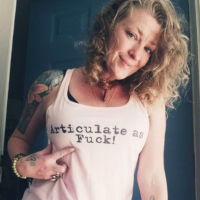There is an imprint on the back of my heart where someone once kneeled on me.
Tears percolate when I think about this.
When I take a deep breath, I can feel the depression that was left there, psychically. I can’t heal what I can’t feel or what I can’t remember.
Our brain’s primary job is to protect us, and one of the ways that it does this is to put us into a trance. Typically, when people think of trance, they imagine a zombie-eyed person performing acts for a hypnotist, possibly in front of a crowd, maybe cawing like a rooster or hopping on one foot. This is the theatrical version.
Truthfully, we go into and out of trances all the time. Trances can be positive or negative. This has nothing to do with our emotions or attitudes, in the sense that most people give this context. What this means is that in a positive trance state, we heighten and highlight certain memories, experiences, and emotions, whereas, in the negative trance state, we do the opposite—we make them disappear.
There have been several incidences in my life where I experienced physical violence from people who I thought cared about me. I remember a few of these incidents. There are also a few I do not remember.
I was sharing with someone close to me about how I was feeling frozen and doubting myself while I was trying to communicate with my current lover. This person then disclosed to me a story of what had happened to me once—a violent incident that I do not remember. As they told me, my hand went to my throat.
I have a negative trance around this experience. I don’t remember it—but my body does.
My fear of speaking has limited me in the professional sense as well as the intimate. I used to second guess every point I had made when I would do an interview. Enough practice has eased that, but in the relational realm, I still have difficulty.
It’s important to understand this type of trance is a protective mechanism. My inability to remember these incidences is how my brain sought to defend me when I could not defend myself.
When we are threatened, we tend to do three things: we run, we fight, or we freeze. Along with these reactions comes a surge of hormones that are released when our sympathetic nervous system activates. Norepinephrine floods the muscles of our heart, as well as skeletal muscles, causing them to contract in preparation for taking action.
If we cannot physically leave a situation, we will leave in other ways. We may dissociate—staying lost in those memories that may not even be conscious to us or form other fantasy worlds as a means of escape. Those feelings, as well as hormones, that occurred at the time of the experience, however, may not get discharged from our body for years. From that dissociative place, we will often recreate the scenario in an attempt to find a resolution. People often refer to this as self-sabotage.
What this really is, is a deep (often unconscious) longing for completion, for care, and for recognition—a desperate message being beamed from what is often a frightened and abandoned inner child, to use the Jungian term.
I have experienced, and performed inner child work, or what is referred to sometimes as a soul retrieval. My preference utilizes both somatic or body-based awareness, as well as intuitive healing. Our psyches respond to symbols—and that is the realm of the mystical. As is the shadow.
These places where we lose or hide or ourselves are the shadow’s realm. When we are operating from a place of fragmentation—as most of us are to varying degrees—those subconscious aspects that seem to be acting out are yearning for recognition and communion.
Why the emphasis on communion over integration?
Integration—like the concept of oneness—can become an amalgamation rather than an acceptance and even celebration of diversity. Yes, our psyches are as diverse as nature, with different needs and motivations that emerge from different parts. It is actually this attempt at unilaterality that creates the shadow, as the parts that are not in alignment with the more dominant components of our psyche usually get suppressed.
If we experienced a threat and instead of running or fighting, we froze, the process that was activated was not completed. It is actually better for us, physiologically, to take action. If we cannot, we may remain in that loop, hormonally and emotionally. This is where, what is commonly referred to as triggers, come into play.
When triggered, we may find ourselves lashing out, as we would in the throes of a fight-or-flight reaction, or we may find ourselves shutting down, as we would in a freeze response. We may find ourselves clenching and tensing, physically, as we would if we were being threatened.
In that moment, we need to pause, take a breath. The first thing that happens when we go into a trance is our breathing changes. We can reclaim that primary process, taking slow, deliberate breaths into our belly. We can check in with our bodies and environment. We can remind ourselves, we are safe.
This long ago, unremembered trauma left me with recurring anxiety. Since it mostly gets activated when it comes to communication—I communicate to heal it. I write. I speak, even when my voice shakes.
From now on, I will be reminding myself, no one is kneeling on me. That was my past; this is my present. It is safe to be here.
Culturally, we tend to have a rather extreme view of what trauma is. I would like to present a simplified definition: trauma is any event that presents as a disruption to our life force, physically or psychologically, and presents ensuing difficulty in our cognitive abilities to process reality and relate to each other.
All trauma is relational. That simply means that we are not alone in experiencing it. Whether it’s childhood abuse or neglect, us falling off of our bikes, being rejected by a romantic partner, or surviving a war zone—all trauma involves us interacting with others. Those others may be participants or may be complicit in our suffering, or they may be there to help pick up the pieces.
Neither hurt nor healing happens in a vacuum.
We need witnesses for our wounds and to reawaken our wonder.
~











Read 32 comments and reply